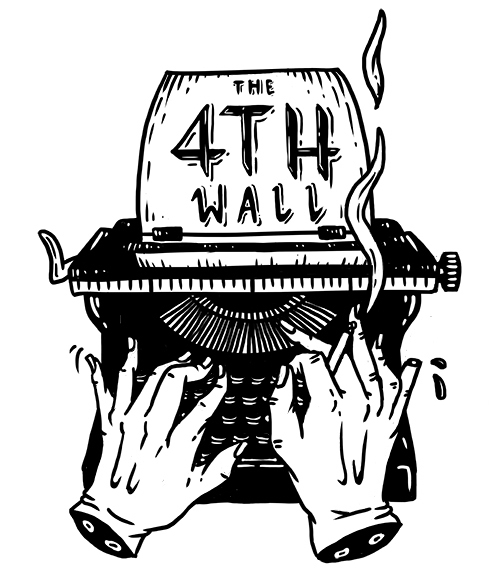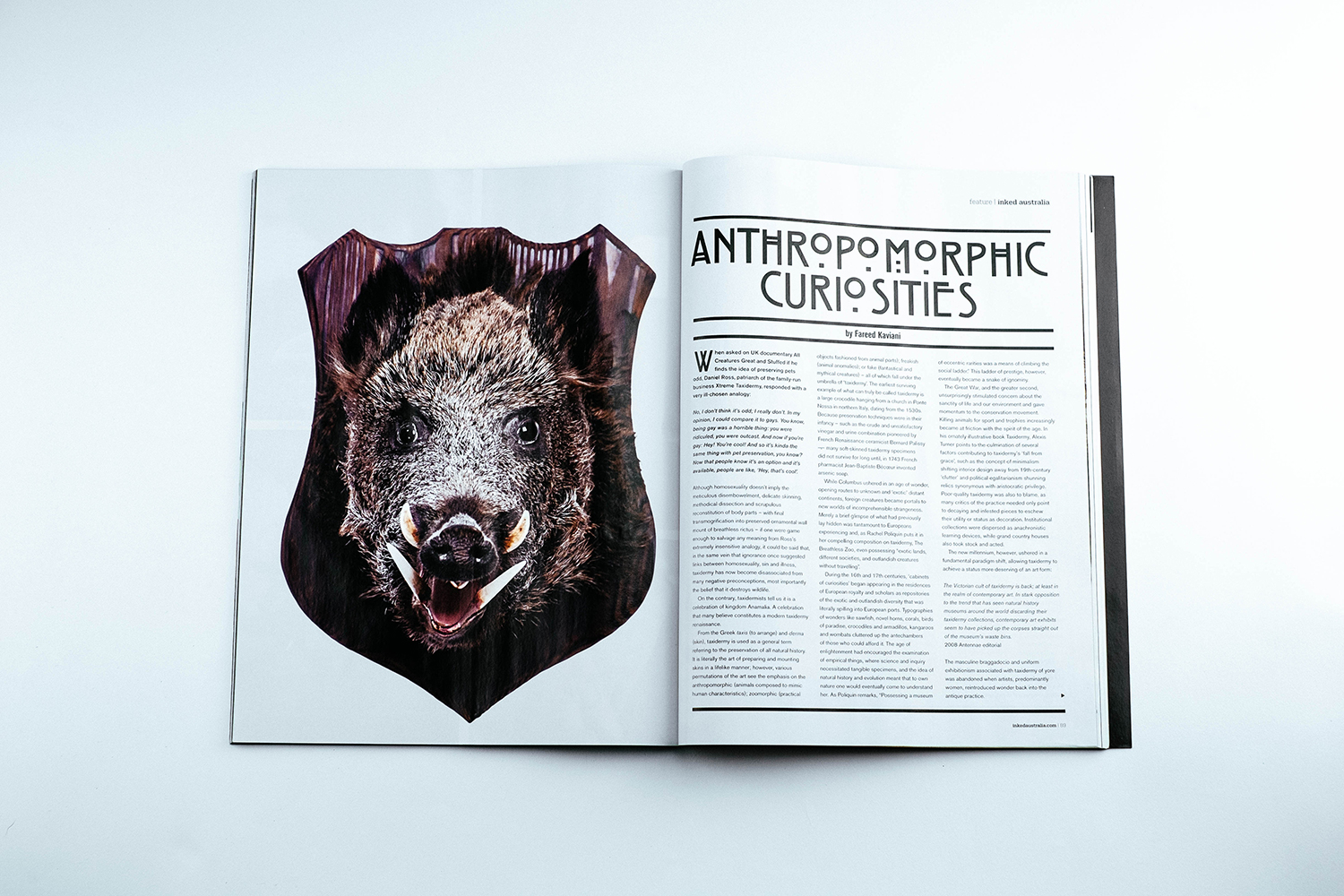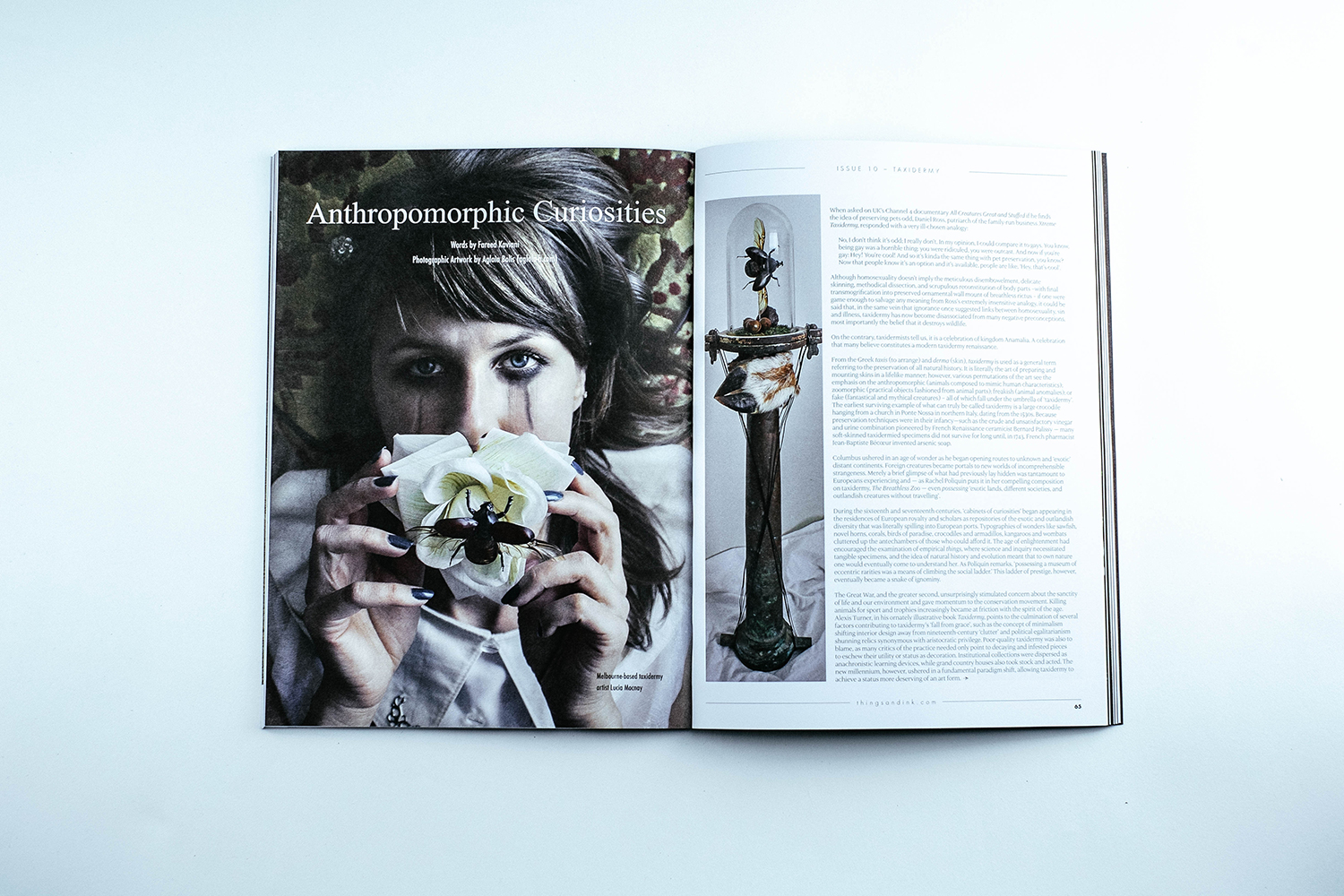Anthropomorphic Curiosities
Taxidermist Lucia Mocnay. Photography by Aglaia B.
From the Greek taxis (to arrange) and derma (skin), taxidermy is used as a general term referring to the preservation of all natural history. It is literally the art of preparing and mounting skins in a lifelike manner; however, various permutations of the art see the emphasis on the anthropomorphic (animals composed to mimic human characteristics); zoomorphic (practical objects fashioned from animal parts); freakish (animal anomalies); or fake (fantastical and mythical creatures)—all of which fall under the umbrella of ‘taxidermy’. The earliest surviving example of what can truly be called taxidermy is a large crocodile hanging from a church in Ponte Nossa in northern Italy, dating from the 1530s. Because preservation techniques were in their infancy—such as the crude and unsatisfactory vinegar and urine combination pioneered by French Renaissance ceramicist Bernard Palissy—many soft-skinned taxidermied specimens did not survive for long until, in 1743, French pharmacist Jean-Baptiste Bécœur invented arsenic soap.
"Nova"
Columbus ushered in an age of wonder as he began opening routes to unknown and ‘exotic’ distant continents. Foreign creatures became portals to new worlds of incomprehensible strangeness. Merely a brief glimpse of what had previously lay hidden was tantamount to Europeans experiencing and—as Rachel Poliquin puts it in her compelling composition on taxidermy, The Breathless Zoo—even possessing ‘exotic lands, different societies, and outlandish creatures without travelling’.
During the sixteenth and seventeenth centuries, ‘cabinets of curiosities’ began appearing in the residences of European royalty and scholars as repositories of the exotic and outlandish diversity that was literally spilling into European ports. Typographies of wonders like sawfish, novel horns, corals, birds of paradise, crocodiles and armadillos, kangaroos and wombats cluttered up the antechambers of those who could afford it. The age of enlightenment had encouraged the examination of empirical things, where science and inquiry necessitated tangible specimens, and the idea of natural history and evolution meant that to own nature one would eventually come to understand her. As Poliquin remarks, ‘possessing a museum of eccentric rarities was a means of climbing the social ladder.’ This ladder of prestige, however, eventually became a snake of ignominy.
"Oswald"
The Great War, and the greater second, unsurprisingly stimulated concern about the sanctity of life and our environment and gave momentum to the conservation movement. Killing animals for sport and trophies increasingly became at friction with the spirit of the age. Alexis Turner, in his ornately illustrative book Taxidermy, points to the culmination of several factors contributing to taxidermy’s ‘fall from grace’, such as the concept of minimalism shifting interior design away from nineteenth-century ‘clutter’ and political egalitarianism shunning relics synonymous with aristocratic privilege. Poor-quality taxidermy was also to blame, as many critics of the practice needed only point to decaying and infested pieces to eschew their utility or status as decoration. Institutional collections were dispersed as anachronistic learning devices, while grand country houses also took stock and acted.
The new millennium, however, ushered in a fundamental paradigm shift, allowing taxidermy to achieve a status more deserving of an art form.
§
“The Victorian cult of taxidermy is back; at least in the realm of contemporary art. In stark opposition to the trend that has seen natural history museums around the world discarding their taxidermy collections, contemporary art exhibits seem to have picked up the corpses straight out of the museum’s waste bins.”
The masculine braggadocio and uniform exhibitionism associated with taxidermy of yore was abandoned when artists, predominantly women, reintroduced wonder back into the antique practice. Melbourne-based taxidermy artist Lucia Mocnay tells me that ‘there has been a split in the industry; the hunting part is taking a back seat to ethical artists. Women are at the forefront of reviving a mainly traditionally man’s hunter-gatherer business … they have a crafty, preserving nature and are coming through and “nurturing” (preserving) already dead animals … animals whose remains would have been discarded and whose death would have been in vain … and they are doing so in a conscious and complimentary way to the animals.’
Lucia
Her attraction to taxidermy emerged at a young age due to her ‘love of things creepy and macabre.’ Learning the trade with the help of a mentor, Mario Pennisi, she now uses a wide range of blades, scalpels, sculpting tools, brushes, needles and thread, and handheld drills and more to create anthropomorphic curiosities. Lucia considers her work a multifaceted mix of art, education, science, decoration, and amusement, with a dose of science fiction, mythology, and the extra-terrestrial. She likes to make people think about fundamental things while simultaneously amusing them, but in the end, she tells me, ‘it depends on how deep the viewer wants to dig’.
How did you come to create taxidermic pieces?
My partner being a tattooist, I have closely watched the trends in tattooing for over ten years. And in these trends—which are sparked from the creative consciousness of hip, young, creative people the world over—there have been, in recent years, many anthropomorphised animals. It sparked my interest in the subject and possibly even initiated my desire to create what I create. It came about organically, with my partner needing a taxidermy fox to draw from for his tattoos, and when we bought one and I saw it close up, I realised that with my Fine Art background, interest in nature, and general arty-craftiness, I could make one myself. I had been looking for a new creative challenge as my kids were growing up and I had more time on my hands, and my interests took me in the science/nature/art direction. From there I began the process of sourcing information on the craft of taxidermy.
"Percy"
Sometimes I see anthropomorphic tattoos and get inspired to create something similar, and I have had tattoo artists drawing upon for reference my dressed foxes for their tattoos. So they work hand in hand.
Why is your work focused on anthropomorphic taxidermy and domes rather than other types of taxidermy?
I am really interested in history and different cultures, humans’ expressions of themselves throughout time and space, and I get to delve into this while researching costumes and gain knowledge while also being creative. It inspires me and excites me. I’m a science and nature nerd and an art nerd and a history nerd and a costume nerd, so all my nerdy parts can come together at once.
Anthropomorphising animals in stories or creation myths has been done since the dawn of time, and it took a huge leap in Victorian times with Beatrix Potter’s work, and all the bedtime fairytale stories my parents told us when we young. There are anthropomorphised animals in most cultures’ ancient stories, passed down from generation to generation, teaching us about our own characteristics by mirroring them in animals; for example, ‘eyes like a hawk’, ‘cunning like the fox’, ‘slippery like a weasel’, ‘proud as a lion’. The animals taking on a human persona teach us about ourselves, and humans taking on animal characteristics give strength to the humans, as in Native American spirit animals.
I love digging into the mythology of different cultures and incorporating them into my work. For instance, my recent piece, Lady Növa O’Leveret the Solitary Witch Hare, leads a double life. While alive she’s a witch and seer, and once crossed over she’s a banshee, a Celtic female spirit, which is usually seen as an omen of death and a messenger from the underworld. In legend, a banshee is a fairy woman who begins to wail if someone is about to die. My hare has a quartz crystal horn protruding from her third eye, which enables her to sense those about to die so that she may release her sorrowful wail in due time.
Another favourite piece is Krampus, an old European mythological character who is St Nicholas’s dark counterpart. He is a tall, horned, hairy devil creature with a tail and hoofs for feet. He carries a broom and has a long winding tongue. The two associates come to visit children on St Nicholas day (December 6th). If you have been good you’ll receive presents and sweets from St Nick, but if you have been bad Krampus spanks you and gives you coal and a broom. If you have been particularly naughty that year, he takes you away in a pouch on his back to his evil lair – the stuff of nightmares! Being from Slovakia, he visited us as kids and my parents keep the spirit alive by dressing up as St Nicholas and Krampus each year and visit my children to scare them into behaving for the year ahead (I wish it actually worked!)
The domes: I love insects and the intricate, hairy, alien-like bodies they have. It’s a way of showing off their utter amazingness in 360 degrees. Which is like a homage to the earthly creations in this world. In frames they are only able to be viewed one-sided. And seeing them live is a rarity.
As well as a growing interest in taxidermy, Mocnay points out the rise in masks and jewellery made of animal parts for ritual:
This is similar to the way Native American’s used or wore elements of their Animal Spirit to embody the characteristics of the animal. People are interested in exploring the old ways and what those ways can teach us. A simultaneous trend is seen in tattoo iconography and in modern mostly female taxidermists. People are exploring tribal and Wiccan ways and codes of practice, and this includes using animal parts, used with respect and obtained morally, and asking for the animal’s characteristics that way. So we therianthropise ourselves. Therianthropy or zoanthropy is the name given to shapeshifting into animal form, which has been depicted in cave paintings. This is what gives me the indication that we won't use and abuse the animals, and the people I interact with are more conscious these days.
What types of people purchase your pieces?
Mostly it has been tattooists buying my pieces, which makes a lot of sense as the trend in tattoos continues. Taxidermy and curiosities are becoming tied in to the tattoo culture in some places—especially curious pieces like two-headed cows and deformed animals. They did the rounds in the olden days in sideshow circus culture for many years, and tattooists have always been on the edge of alternative interests, having tattooed ladies in the sideshow too, so it makes sense the two came together.
Are you vegetarian or interested in animal rights?
I am not vegetarian; I eat meat, but buy free-range or organically sourced meat. I know some taxidermists who eat the meat from the animals they skin, make liver dumplings and try to use every part so that nothing goes to waste. I know others who are full vegan who also work in the field. There is no one stereotype.
I have been a World Animal Protection (formally WSPA) financial supporter for years before I even thought about doing taxidermy.
How can one be sure that the animals are ethically obtained?
Obviously one shouldn’t taxidermy endangered or exotic animals, unless they’re obtained from a zoo if the animal dies of natural causes. Or going out and shooting a koala just so you can taxidermy it isn’t ethical. Speaking in relation to what I do, the taxidermy of foxes in Australia is considered ethical, as the foxes are not solely culled for taxidermy purposes, they are culled for environmental reasons, because they are killing all our smaller, native animals to the brink of extinction. So farmers around the continent shoot and hang foxes on fences, or take them to the government and get a monetary collection for each dead fox. I use the foxes instead of letting them rot. If it were a native endangered Cassowary, it would be another story. n Australia, foxes, feral cats, and boars (among others) are a real problem. Google “foxes in Australia”, and you’ll get the full story. The Victorians brought them here so they had some “game” to hunt, and, being clever, cunning, and horny. they over-populated and spread to all corners of the continent. We have the highest amount of feral camels in the world too, something that many people wouldn’t know. And these animals that weren’t naturally meant to be here are causing ecological disasters.
Generally, however, a lot of modern Taxidermists don't kill. I haven't killed an animal in my life bar one snake I ran over in my driveway once. Taxidermists work with the left over remains they acquire from many means. They trade/buy/are gifted dead animals/pelts and work to restoring the animals lifelike state.’
§
Because today nearly all natural science wonders are observable by the click of a button, the contemporary revival movement has found itself playing a very different role from Victorian era’s unravelling of the unknown and obscure. Rising from the ashes of a once largely male preserve, taxidermy has reinvented itself as an exotic consumer commodity within twenty-first century realms of art, design, fashion, and media. And because, as Rachel Poliquin succinctly observed, ‘A wonder is not a wonder if it fails to startle and disrupt expectation,’ specimens are ruthlessly manipulated and obscured to meet the demands that consumer wonder insatiably requires. This new zeitgeist has become fertile grounds for accusations of animal objectification.
Do you think there’s an argument to be made that by appraising taxidermy as an artistic pursuit merely masks the fundamental insensitivity of stuffing and displaying animals, and reaffirms our perception of animals through a use/value frame? Isn’t taxidermy the epitome of the objectification of animals, and are you concerned where taxidermy could lead once it ceases to titillate and entertain?
No, I think the leather industry takes the cake for that. Think about handbags and belts and the shoes you’re wearing. It was once a living thing, and now it’s a commodity for our use. At least we appreciate the beauty of the animal when it’s in taxidermy form and not completely pass it by as we do with shoes and belts.
It comes down to your spiritual beliefs as well. We also use human cadavers for scientific research once we pass away, not only animals. Once something is dead it either rots to nothing or it can be preserved. I don’t think the spirit of the animal stays with its dead body. And if that’s the case, then preserving the beauty it once was is not a bad thing.
Most people understand that taxidermy is done with the leftover skins, and so it is separate from the live-animal debate, and the leather/fur debate, which uses farming. Animals are not objects, but taxidermy pieces are objects. If taxidermy is made into art for art’s sake, there is still the beauty and appreciation of the animal and the art, so it really isn’t for nothing. There is something to gain out of all art. There are and always have been extremists in every field, and I daresay my work is in the “safe” category when it comes to extreme taxidermy. I just do what I do with integrity and hope that permeates my work.
Photography by Aglaia B.

















